2022
Land of Prey – Witch-hunting in the 21st century
The sixth edition.
Edition six focused on the ongoing witch-hunts in the world today, with a glance at the persecutions of the past combined with contemporary artistic practices.
Land of Prey was curated by Tanja Sæter and the Gambaga and Ghanian part of the program was co-curated with Larry Ibrahim Mohammed.
The presentation of Marita Isobel Solberg and Henrik Sørlid was co-curated with Kurant9000.
Locations: Tromsø and Bergen
Dates: 26.09.-02.10. 2022.
Witch hunting and witches is frequently addressed as a romanticized phenomenon of the past.
A ghost. A myth.
Yet we should remind ourselves that there is nothing past, immaterial or mythical about the thousands of women that bear the accusation of being witches to this day; who are tortured and murdered. The realities of witch-hunts are still very much with us.
Why is this important matter not on the worlds agenda?
We wanted to draw attention to the fact that women are brutally hunted as witches in 2022. With the use of activism, the law, poetry, internet, personal stories and discussions we tried to shed light on the situation in various ways, and link todays situation with historical witch-hunts. Hopefully we contributed to some new thoughts and more attention to the fact that we co-exist in a time where women are still slaughtered as “witches” in ways just as cruel as in the 16th century. According to the United Nations witch-hunts and attacks are ongoing in 38 countires and increasing on a global scale.
At the same time we presented a part of the vibrant, spiritual, eco-critical and interesting local art scene in Tromsø, Sápmi and in Bergen intertwined in the program.
As a preparation for edition six we recommend reading the thesis by co-curator Larry Ibrahim Mohammed about the “witch” camps in Northern Ghana.
BETWEEN ALIENATION AND BELONGING IN NORTHERN GHANA: The voices of the women in the Gambaga 'witchcamp'. Thesis Larry Ibrahim Mohammed, UIT.
Larry’s research work was awarded the Åse Hiorth Lerviks prize for the best master thesis with a gender theoretical perspective in 2021.
Edition six was supported by The Arts Council, the Ministry of Foreign Affairs and the Embassies in France and London and the Consulate General in New York, Music Norway, Tromsø Municipality, Bergen Municipality and Stiftelsen Fritt Ord.
Artists and Speakers 2022
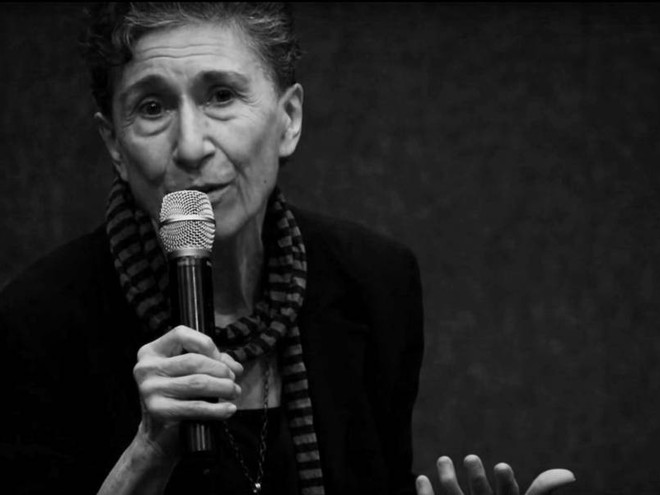
Silvia Federici / Witch-hunting in the 21st Century
Silvia Federici (from Italy based in New York) is a legendary feminist activist, writer, and a teacher.
Federici participated with the Keynote lecture Witch-hunting in the 21st Century.
In 1972 she was one of the cofounders of the International Feminist Collective, the organization that launched the Wages For Housework campaign internationally.
Her books include Witches, Witch-Hunting, and Women, Caliban and the Witch: Women, the Body and Primitive Accumulation, Re-enchanting the World: Feminism and the Politics of the Commons among others.
She is one of the co-founders of the Committee for Academic Freedom in Africa, an organization dedicated to generating support for the struggles of students and teachers in Africa against the structural adjustment of African economies and educational systems. From 1987 to 2005 she taught international studies, women studies, and political philosophy courses at Hofstra University in Hempstead, NY.
All through these years she has written books and essays on philosophy and feminist theory, women’s history, education and culture, and more recently the worldwide struggle against capitalist globalization and for a feminist reconstruction of the commons.

Suuk Laari & Samson Laar / Life in the Gambaga "witch" camp
Accused of being a witch and banished from her village, Suuk Laari (Ghana) has been living in the Gambaga camp in North-Ghana for the last 15 years. Without a trial or a jury she is one of 85 women and three men sentenced to live in the Gambaga camp in order to save their life.
Suuk Laari participated as our Guest of Honour to speak for the women in the camp and to bring attention to modern witch-hunting. The surge in witch hunts is a global problem, currently ongoing, and increasing according to the UN, in 38 countries.
Samson Laar (Ghana) worked as a coordinator in the Gambaga camp, fighting an ongoing battle to stop witch-hunting in Ghana and to spread information about their situation.
Laar spoke of the recent surge in witch-hunts and women arriving at the camp seeking refuge and how he works with the women found guilty of witchcraft.
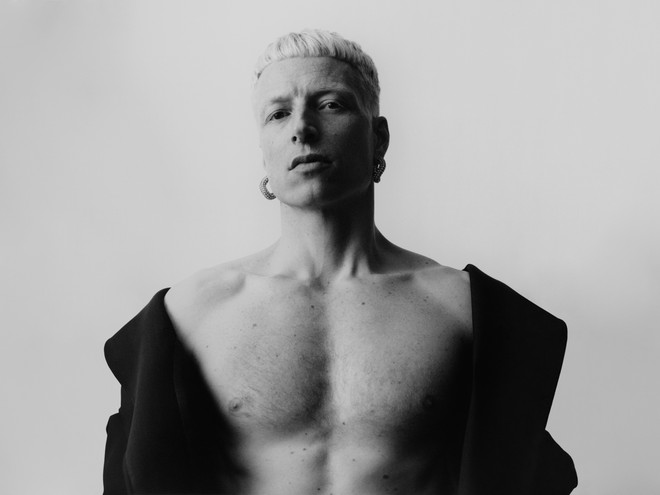
Bendik Giske / Performance at Prostneset, Tromsø
Bendik Giske (from Norway, based in Berlin) is an artist and saxophonist whose expressive use of physicality, vulnerability and endurance have won him much critical acclaim.
Giske participated with a performance at Prostneset Harbor terminal in Tromsø.
Circular breathing for the saxophone, the technique he employs to mesmerizing effect, induces in the player – and perhaps the listener, too – a kind of altered state, more open to discovery, and as a cycle of sound it defies time.
The body is important for Giske, and his practice – rooted in queer theory from José Esteban Muñoz and the likes – refuses to commit to the world of music alone.
With artistic collaborators such as Wu Tsang and boychild, Hanne Lippard and Theresa Baumgartner, to name a few, it also encompasses music for film, theatre, site specific works and immersive, embodied performances.
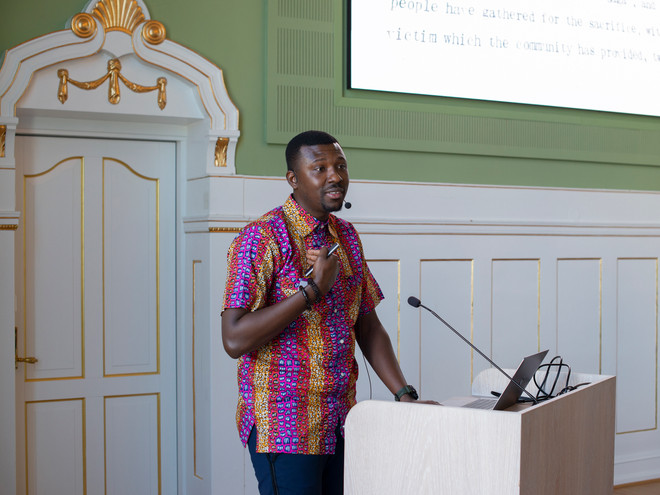
Larry Ibrahim Mohammed / Ending witch-hunts in Ghana – Historical lessons for contemporary challenges
Larry Ibrahim Mohammed (from Ghana, besed in Tromsø) was the co-curator of the Ghanian part of Land of Prey, and he grew up in Nima-441, a suburb of Accra in Ghana. He is currently a PhD Research Fellow of Comparative Indigenous Studies at UiT- The Arctic University of Norway, where he investigates the nexus between indigenous peoples’ self-determination and various extractive activities in Norway and Canada.
Larry’s research work: BETWEEN ALIENATION AND BELONGING IN NORTHERN GHANA: The voices of the women in the Gambaga ‘witchcamp’ (uit.no) was awarded the Åse Hiorth Lerviks prize for the best master thesis with a gender theoretical perspective in 2021.
He has since delivered several lectures on different aspects of his research on the Gambaga witchcamp. Larry Ibrahim sees himself as a Global Citizen who believes in working to make the world a better place.
Larry has participated as a delegate in two Youth Assemblies at the United Nations in New York and volunteered at the 12th Expert Mechanism on the Rights of Indigenous Peoples (EMRIP) in Geneva.
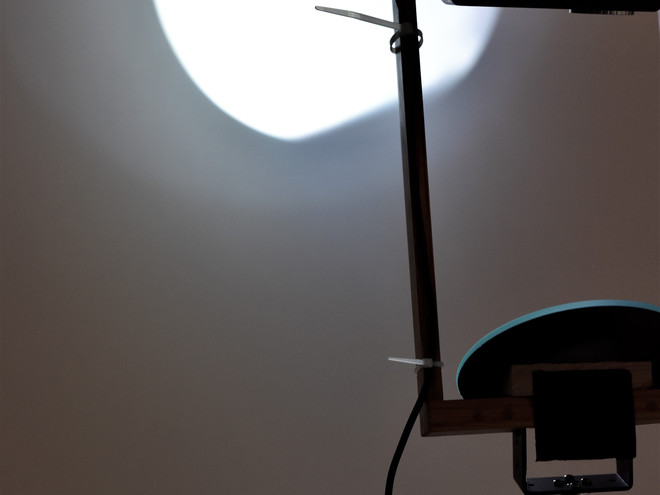
Nora Adwan / Mouth of Ashes (Kinetic sculpture at Tromsø Kunstforening)
Nora Adwan (from Palestine, based in Bergen) participated with a new commissioned Kinetic sculpture with the video “Mouth of Ashes” (5 minute loop), screened at Tromsø Kunstforening.
Mouth of Ashes
Kinetic sculpture with 5min video loop
Signs of a witch child: Too loud, too quiet, being sick, having fevers, bed wetting, defiant, spending too much time outside, playing separately from other children, crying too much etc.
The sculpture takes the role of a child accused of witchcraft, confused and disoriented it ‘speaks’. The movement of the video makes it hard for us to listen, the words zip by hard to grasp easy to ignore, distorting on an elemental background of light on water or shadows from a fire. The form references both old and new technologies, the pyre, the scaffold and the communication tower, the satellite. Gossip, misinformation, and superstitions now fly around the world, taking root in disparate communities, festering.
Archaic and new ideas blend, technology and religion, and someone always profits from suffering.
Accusing children of being witches in 2022 is not confined to one religion or place, this is global.
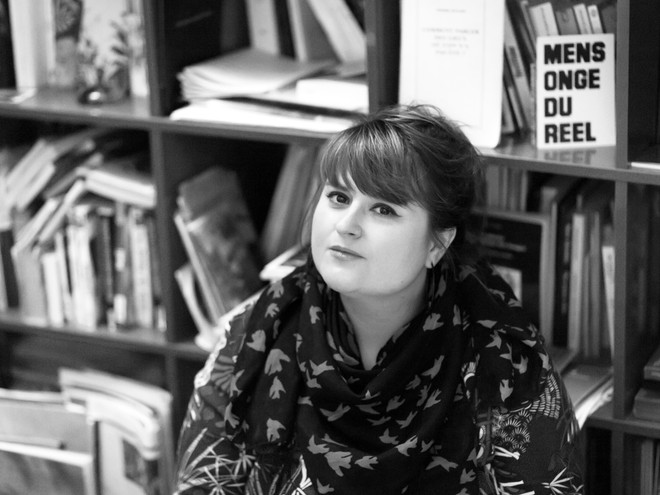
Marianne Derrien / On the Use of Occult, Magical and Alchemical Forces : the Counter-Worlds of Contemporary Art
Marianne Derrien (FR) participated with the lecture On the Use of Occult, Magical and Alchemical Forces : the Counter-Worlds of Contemporary Art
Based on her Essay with the same title, published in the catalog Possédé.e.s, the lecture is the result of several researches on witchcraft specifically around the figure of the witch and “monstrous” female/queer figure participating in forms of political and social emancipation.
Marianne Derrien is an independent curator, art critic, teacher and vice-president of c|e|a, association française des commissaires d’exposition in France.
After working as project manager for the exhibitions at the French Academy in Rome – Villa Medici, she now collaborates with institutions and independent venues in France and abroad as guest curator at Mrac Occitanie-Sérignan, Mudam – Luxembourg, The Pill – Istanbul and the Wooyang Museum – South Korea.
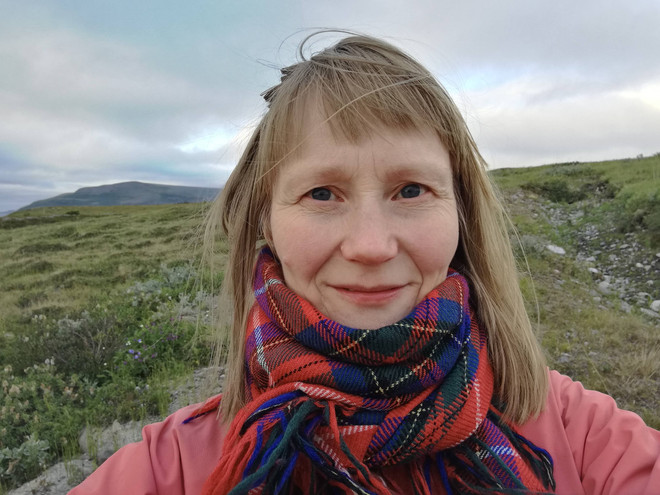
Lill Tove Fredriksen / The Unwritten Story (conversation)
Lill Tove Fredriksen is Associate Professor in Sámi Literature at UiT the Arctic University of Tromsø.
She participated in the conversation The unwritten story with poet, activist and artist Synnøve Persen.
Fredriksen has published widely in the Sámi language, and in Norwegian and English, on coping skills and traditional knowledge in Sámi literature. She received her PhD from UiT the Arctic University of Tromsø, Norway, focusing in the thesis on the coping skills in the novel trilogy "Árbbolaččat (“The heirs”) written by the Sámi novelist Jovnna-Ánde Vest.
She has a special interest in the Sámi language, the history, the development and the situation of the language in today’s society. She also participates in the public debate concerning Sámi issues.

Viktor Pedersen / To see without man (screening)
Viktor Pedersen was the winner of the Coast Contemporary price 2022!
Awarded in collaboration with the Oslo Open Art Festival.
Pedersen participated with a screening of the new film To see without man. The work is a collaboration with artist Ingrid K. Bjørnaali.
For the film Ingrid K. Bjørnaali has worked with 3D scans of plants from the Nightshade family (Belladonna, Mugwort, and Tobacco) which are used for medicinal and ritual purposes, and are grown by Viktor Pedersen at home.
Viktor Pedersen works interdisciplinary with video, performance, sound, and text. In his artistic practice, he approaches non-human intelligence to look at how we interact with other organisms, such as plants and yeast, in conscious and unconscious ways.
Through storytelling Pedersen employs the perspectives of different beings—an alien from another dimension, yeast who influence society, or the bacteria in his body. With these voices he desires to challenge and play with the idea of human exceptionalism.
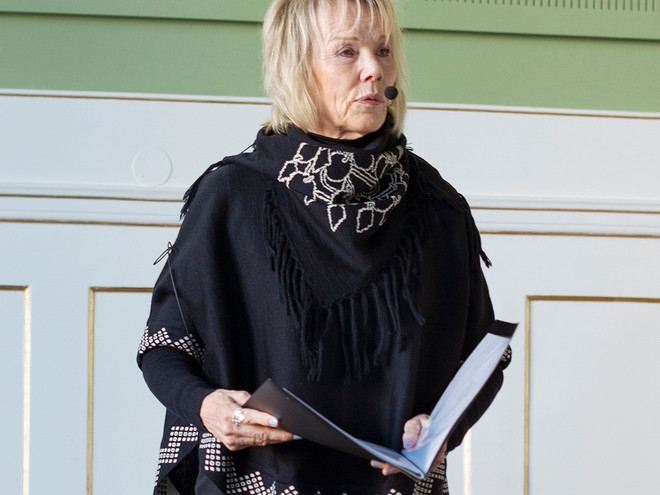
Synnøve Persen / Poetry reading and The Unwritten Story (conversation)
Synnøve Persen participated with a poetry reading of her Sámi and Norwegian poetry, and an introduction of her newest research on the female side of her Sámi family, including a witch-hunt on one of her fore-mothers, dating back 400 years in time.
This was followed by a conversation between Lill Tove Fredriksen and Synnøve Persen titled The unwritten story.
Synnøve Persen made the first draft for the flag of Sápmi, that later became the official Sápmi flag and was a founding member of the Sami Artists’ Group 1978–83.
“I have worked with unionizing Sami artists and for the establishing of institutions for Sami Art, as the Sami Center for Contemporary Art and a Sami Art Museum.
My poetic language is North Sámi. The Sámi language is considered to be one of the narrowest and most threatened languages in the world. Sámi belongs to the Finnish-Ural language group and is most closely related to Finnish.
In the course of twenty years in the Norwegian education system, I neither learnt to read nor write my mother tongue. The Sámi language and culture were not topics for discussion. It gave one a feeling of emptiness, an inner anonymous space, a feeling of being a stranger in one’s own life. It was only when I grasped my mother tongue myself, and made the first hesitant attempts at writing, that I became able to write poetry.
In 2017 I participated at documenta 14 at the National Museum of Contemporary Art in Athens, Greece."

Marita Isobel Solberg / WOOLWALKER performance at Alfheim, Tromsø
Solberg participated with the performance WOOLWALKER at Alfheim public bath in Tromsø.
Presented in a co-curatorial collaboration with Kurant9000.
Marita Isobel Solberg is a visual artist, chanter, musician and composer. Her expression includes performance art, ceramics, sound, music and installation. Marita has ancestral roots from a net of Nordic folks like the North-Norwegian, Sámi, Swedish, Kvenish and Finnish people and grew up in Manndalen / Olmmáivággi / Olmavankka in the North of Troms.
The common denominator for her projects is the intention to challenge the audience – and herself, to try reaching into the innermost and create vibrations with repercussions. Her artistic themes circle around a core of intuitive presence, togetherness, spiritual technologies, connections and reflections around wholyness.
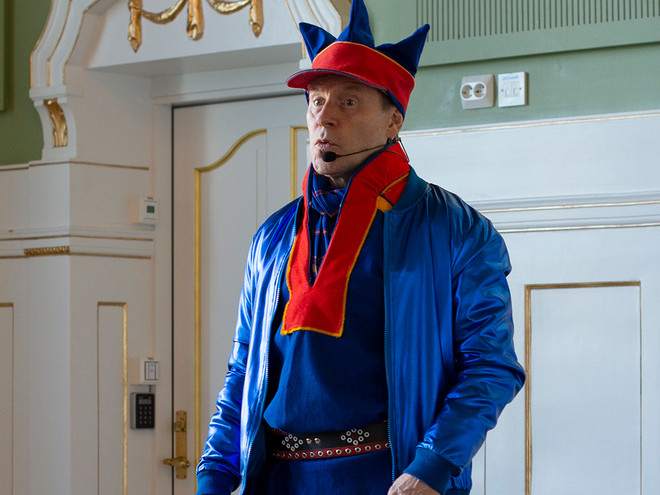
Ánde Somby / Joik and lecture performance
Ánde Somby participated with a traditional Sami joik for our opening performance, and with a presentation related to topics addressed in Land of Prey.
Ánde Somby, born 1958 in Buolbmat, Norway, is a traditional Sami joik artist and Associate Professor of the Faculty of Law at the Arctic University of Norway, specializing in International Indigenous Rights Law and Legal Theory. He holds the subject of international indigenous law at UIT. He also teaches legal sociology Sami law, state law and ex fac.
Somby is only one of few Sami with Ph.D. in law (dr. juris). Somby’s Ph.D. is titled “Juss som retorikk”. In that thesis he reconnected the Nordic jurisprudence to the classical rhetorical tradition which dates back to Plato and Aristotle. In 2009, Somby was working on a project titled “Is the legal medium the legal message?”, in which he attempted to apply Marshall McLuhan’s mantra on the medium being the message to jurisprudence.
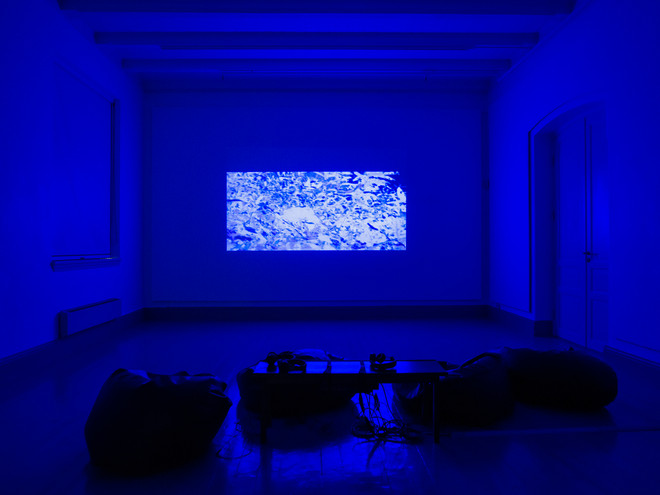
Henrik Sørlid / Cartesian Nightmare (screening at Tromsø kunstforening)
Henrik Sørlid participated with his new film Cartesian Nightmare (2022).
Presented in curatorial collaboration Kurant9000 at Tromsø Kunstforening.
Cartesian Nightmare (2022) is a new video work commissioned for Coast Contemporary 2022 and co-produced by Kurant9000. It is a brief meditation on the wider social, economical and spiritual impact of Cartesian mind-body dualism, with particular emphasis on how mechanistic philosophy has warped our understanding of dreams and magic, and building on the work of historian Edward Bever.
Drawing upon Situationist notions of détournement – the hijacking and repurposing of existing cultural materials to create new worlds of meaning and affect – his collage works are produced through a sort of material analysis of visual representations of time, history and knowledge. But rather than being a vehicle of critical analysis in any narrowly defined sense, these works are searching for hidden worlds that can be seen as being implicit or camouflaged within the forms, colors and textures thought to represent a rational account of this world.

Silje Figenshou Thoresen / A stick is never to short/too long
Silje Figenschou Thoresen (b. 1978 in Kirkenes) is a Kven and Northern Sami artist from Kirkenes in Eastern Finnmark.
“I grew up in a design tradition where improvisation is essential. You yourself fix the everyday problems that arise, wether this is a repair, a construction, a small object to keep the door open or a building to keep other objects stored. It might be a cage to dry reindeer hearts or a floating pier built and used by a fishing community. There is a certain flow in these objects, and materials are not changed for aestehetical reasons. If a stick is too long, you find another stick, because who knows when you’ll need that long stick. The stick might be part of a shed, then a fence, then something keeping the door shut. In between it will be stored, and when no longer useful, it will be left to rot.
The aestehetical outcome of any of these constructions are based at the materials at hand, your knowledge and your lack of knowledge, your own and your community’s skills, the season and the landscape."
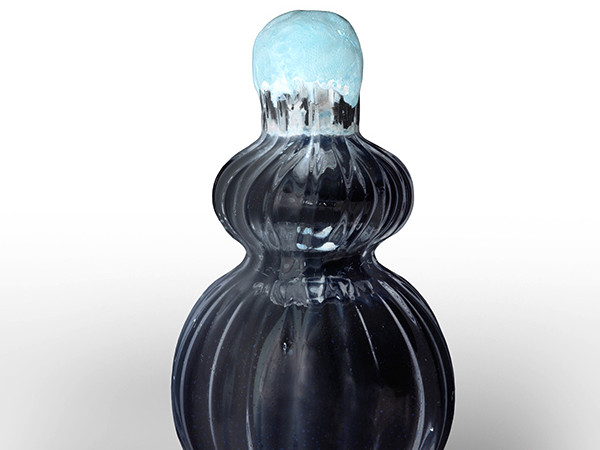
Lesia Vasylchenko / Witch-hunt, technocapitalism and visual culture
Lesia Vasylchenko was born 1990 in Kyiv, Ukraine and is based in Oslo, Norway.
She participates with the presentation Witch-hunt, technocapitalism and visual culture followed by a roundtable discussion about the matters addressed, and how we can use the internet for global attention towards ongoing witch-hunts.
Vasylchenko is an artist and curator. Her work with installations, moving images and photography raises questions around temporality, history and memorialising. She works across a range of media including video, photography and installation.
She is also a co-curator of the artist-run gallery space Podium and a founder of STRUKTURA. Time, a cross-disciplinary initiative for research and practice within the framework of visual arts, media archaeology, literature, and philosophy. She holds a degree in Journalism from the Taras Shevchenko National University of Kyiv and Fine Arts from Oslo National Academy of the Arts.
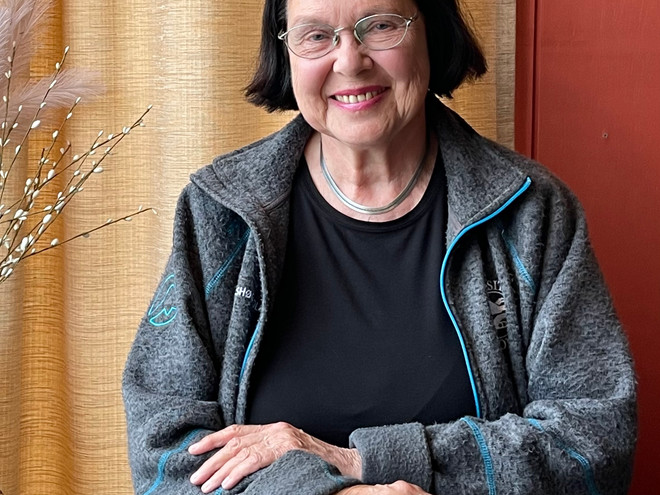
Liv Helene Willumsen / The Witchcraft trials in Finnmark
Liv Helene Willumsen participated as keynote speaker and she introduced the history of the Witchcraft Trials in Finnmark.
Willumsen has written the 91 exhibition texts for the Memorial Hall at Steilneset Memorial in Vardø, commemorating the 91 people who lost their lives during the Finnmark witchcraft trials in Vardø. Steilneset commemorates those who lost their lives during the seventeenth-century Finnmark witchcraft trials. Steilneset Memorial consists of three components: Art, Architecture and History.
The French-American artist Louise Bourgeois has created an installation; around a chair with a burning flame in the middle, seven mirrors are placed, reflecting the flame from different angles. The installation is placed inside a glass pavillion, which is drawn by the Swiss architect Peter Zumthor.
Inside the Memorial Hall there is an exhibition of 91 texts, one text for each individual who lost her or his life during the Finnmark witchcraft trials. These texts are written by historian Liv Helene Willumsen, on the basis of original court records from the seventeenth-century witchcraft trials. The exhibition texts are also published in a book, provided in four languages; Norwegian, English, German and Finnish.

Kurant9000 / ‘We are untamed, we live in the ecotones’
Kurant is an artist run space in Tromsø which has existed since 2009. Autumn 2021, Kurant mutated into Kurant9000 – a project focusing on emerging artists connected to the land in the circumpolar areas.
Kurant was co-curating and co-producing the representation of Marita Isobel Solberg at Alfheim Public Bath and Henrik Sørlid at Tromsø Center for Contemporary Art. The artists and curatorial team behind the project is Ellen Vikström, Thor Birkedal, Amalie Holthen, Lea Joakim Svendby, Carla Wedderkopp, Andrea Flakstad Conradsen and Anna Näumann.
‘We are untamed, we live in the ecotones’ is a two year art program presented by Kurant9000, aiming to amplify young voices in circumpolar north. The program is an entanglement of bodies and landscapes going through rough transitions. Through the gaze and the experiences of us, living in the northern region, identifying as outside the norm.
Dominating and heteronormative structures dissolve when Kurant9000 wakes to life.
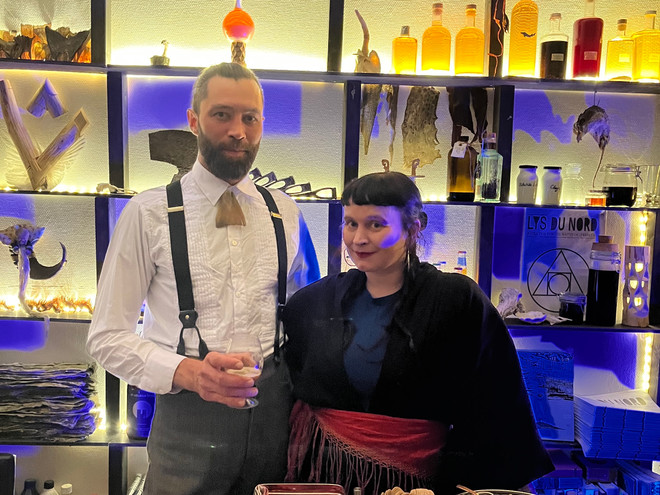
BAR DÛ NORD / Performance at Kysten
BAR DÛ NORD is a performance bar by Marita Isobel Solberg and Trond Ansten held at our final night in Tromsø, in the Kysten studio building in Trond Anstens studio.
- In our establishment, a hybrid mixture of history, future and scientific meditation is served.
Come inside to see, listen, touch, smell, sniff, have a sup, a shot, a sniff or a touch!
Also remember to read our own timeless magazine “Lys Du Nord”.
SOL&STEN explores our close resources and stories in an alchemical remix of past, present and future.
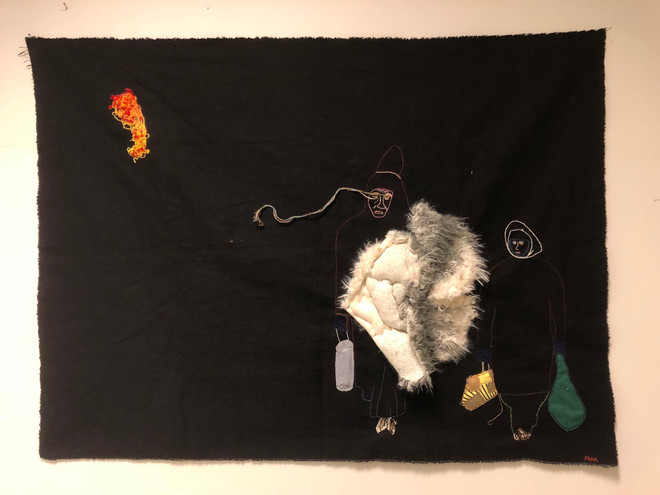
Marsil Andjelov Al-Mahamid STUDIO VISIT
I work with theme of remembrance with focus on ww2, I work with people, handmade embroidery as Social Sculptures and video.
Marsil Andjelov Al-Mahamid was born in Jugoslavia, and has been based in Tromsø since 2009.
“The needle shows the way, breaks through, points towards you, us, backwards, forwards and all the way to where we stand now and remember”. The needle in the Marsil Andelov Al-Mahamid embroidery Forced Evacuation of Finnmark (2018) refers to two people – a grandmother and her grandson – during the forced evacuation of Finnmark in the years 1944–1945. Through fragments of collective memories taken from archives and news as well as personal memories, images and stories, Al-Mahamid places the stories into a complex network of thoughts and ideas that stretch from the Second World War to the present day."
Text by Marius Moldvær / Billedkunst
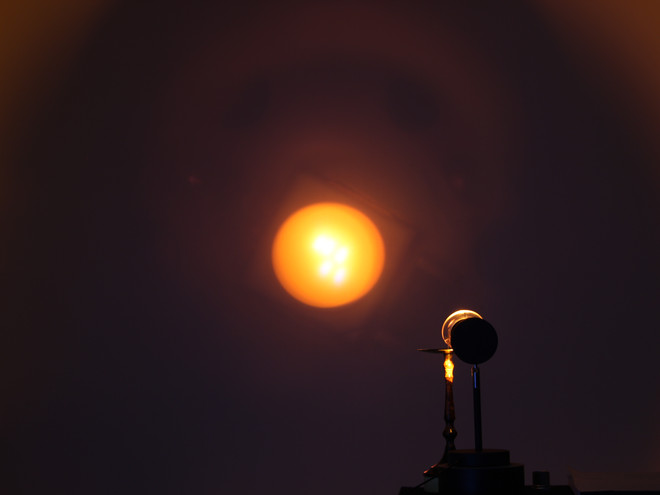
Ruth & Alexander (Ruth Aitken) STUDIO VISIT
Ruth Aitken (often working as Ruth & Alexander) works with the intersection between production and labour, systems of power, the ethical systems which underpin them and the rituals that ultimately appear. This has recently been explored through thinking about distribution, where material, form and content are dictated by a thinking around access and the infrastructure through which power, information and resources are distributed.
Co-founder of Failure, Understanding, Care (& Kunst) and [KINOBOX].

Trond Ansten STUDIO VISIT
Trond Ansten (b. 1984, Bamble, Norway) works with film, sculpture and relational art in a symbiosis of biology, craft traditions and innovation.
With a strong passion for hunting, fishing and gathering his films are built in a performative language that embraces the landscape and rais current questions. A hybrid blend of mysticism and surreal sculptural images are present.
In his sculptural praxis, Ansten explores our relation to nature through harvesting material from the wild. Central is slaughter waste, herbs and algae where wood often is the binding element. Recent works explore trapping architecture, seaweed-farming, fish glue and old Norse brewing technologies.
An important turning point is traditional refining processes seen in the light of new science. What is there of forgotten knowledge that can open up new potential?

Liv Bangsund / KVÄÄNIBIENNAALI STUDIO VISIT
Liv Bangsund is a visual artist born in Tromsø. She uses her knowledge of former northern Norwegian sustainable societies were organized as inspiration for her art projects.
Through active participation and untraditional use of materials, she explores how art can contribute to new knowledge production in society. Since 2014, she has been project manager for Tromsø Folkekjøkken. (Tromsø Peoples Kitchen) where food whaste is used for social cooking gatherings. She explores how alternative structures can operate in parallel with a capitalist system – a form of constructive resistance that works from the inside, and is productive instead of critical.
Her latest work involve the establishment of Kvensk artist union and the Kvenbiennalen in Vadsø, Finnmark. Kvener is an ethnic, religious and/or linguistic minority with long-standing ties i Norway. Kvens/Norwegian Finns, Jews, Forest Finns, Roma and Romani/Tater people have national minority status in Norway.
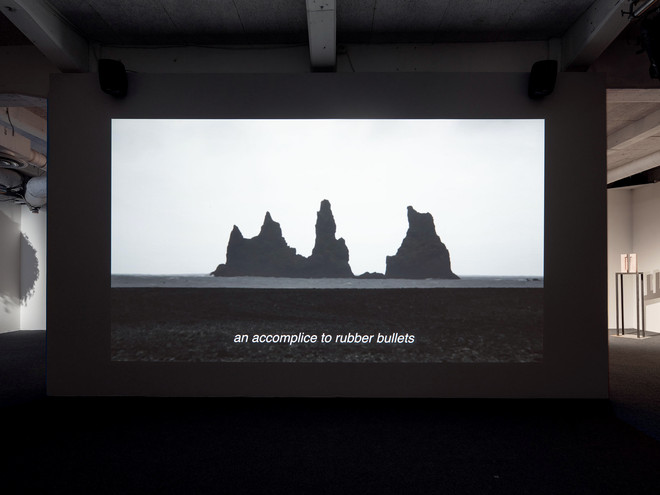
Tanya Busse STUDIO VISIT
Tanya Busse (b. New Brunswick, Canada, lives and works in Tromsø, Norway) is a visual artist working across the mediums of moving-image, installation and photography.
Her practice explores the synthesis of nature, often combined with an industrial, post-human presence. She is interested in deep-time, invisible architecture, and how power is produced and articulated through material relationships and histories of place.
She is also the co-director of New Mineral Collective, a collaborative practice that explores landscapes of extraction, and Mondo Books, an independent book platform that publishes and distributes printed materials across the circumpolar north.
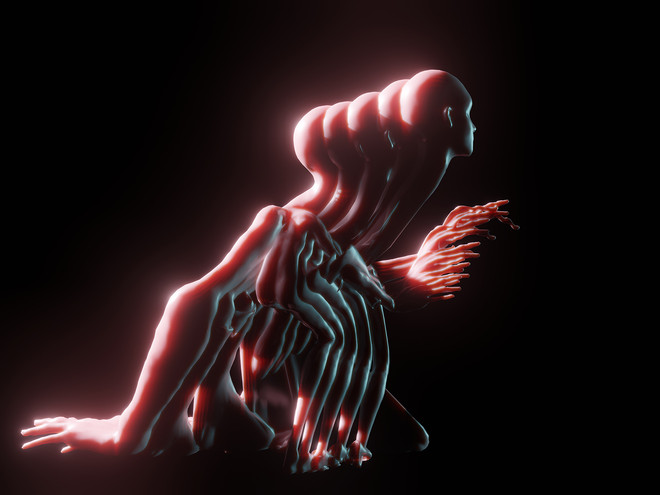
Markus Garvin STUDIO VISIT
Marcus Garvins practice consists mainly of drawing and interactive digital installation.
While studying, the intersection of art and video-games was a big focus, expressed through dystopic video-game installations.
In the two years after 2020 he has been more interested in the interpersonal.
how much can you communicate with very little.
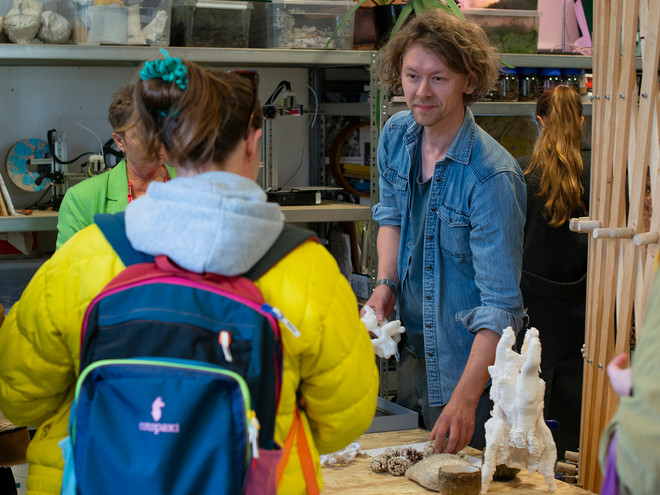
Kåre Aleksander Grundvåg STUDIO VISIT
Kåre Aleksander Grundvåg (b. 1984) is a visual artist based in Tromsø. In his work, Grundvåg has the coastal landscape in Troms both as a frame of reference and as a home.
He is currently exploring non-human architecture through sculptural interventions in public spaces. Material knowledge, vernacular problem solving and biomimetics are important elements in his work.
Together with visual artist Trond Ansten, Kåre Grundvåg formed the artist duo Devils Apron, which explored ecological and social experimentation around the use of seaweed and marine resources, with a focus on combining traditional knowledge, coastal culture and recent research.
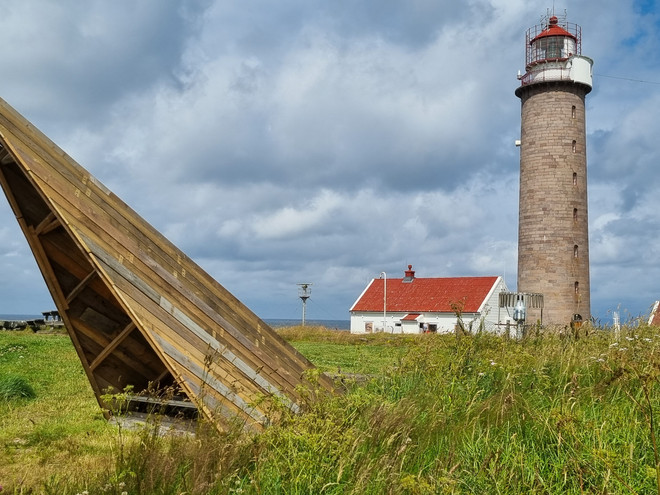
Robert Julian Hvistendahl STUDIO VISIT
Robert Julian B. Hvistendahl (b. 1987) works primarily with recycled wood, sculpture and energy.
His work explores human relationships on a political, social and emotional level by creating complex moments of material tension. This tension makes it possible for the pre-existing qualities in the materials to work with and against each other, keep an apparent status quo, transform explosively, or almost imperceptibly degrade.
For the upcoming year his main project will be "‘Materialbanken for Kreative Prosjekter’ (MFKP) in collaboration with fellow artists Amalie Holthen and Rurik Sjösten. It is a project where they will gather, archive, and distribute recycled materials. In addition, they will archive and communicate the stories connected to the materials. MFKP is a pragmatic response to climate change and the art world’s role within it but also an investigation into what a material is and the potential of what it can be.
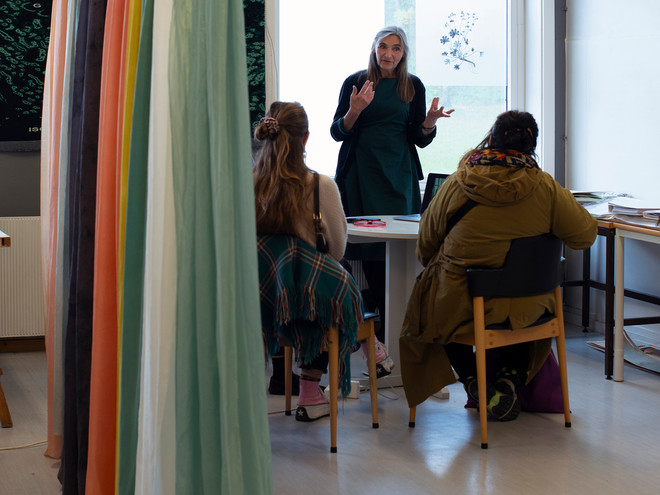
Hilde Hauan Johnsen STUDIO VISIT
Hilde Hauan Johnsen is an artist who constantly finds new ways to combine traditional textile techniques with new technology. The interest for textile is rooted in a curiosity for materiality, for the tactile, the feeling in combination with art installations and sculpture.
In 2018, she was awarded the Ulrik Hendriksen Honorary Award. Since 2007, She has collaborated with Maia Urstad in large optic sound installations.
In Hauan Johnsen´ artistic expression is plant dyeing, which has been part of her art practice for many years. Art projects where she maps and archives landscapes/places by dyeing large textiles with plants.
She has, among other, worked with plants at the borders between Norway/Russia and Palestine/Israel. Can she return in two years / five years to the same places and find the same plants and the same borders? Geopolitical – and climate questions are asked in these works of art.
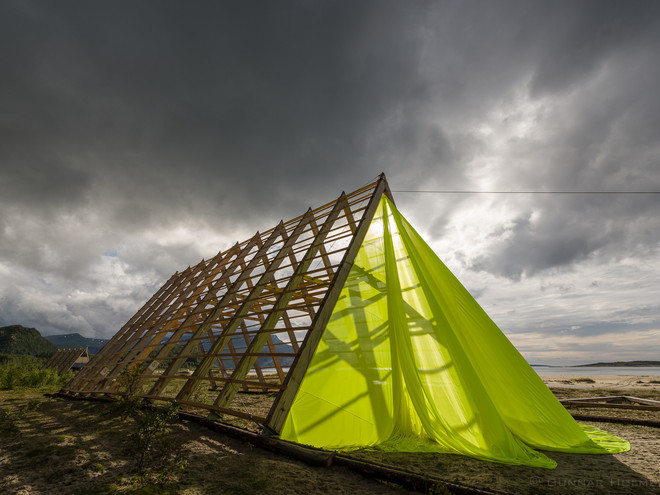
Edvine Larssen STUDIO VISIT
Edvine Larssen mainly works with large scale installations, clearly rooted in a site bound practice valuing time as well as space as active material components. Her works are conceptual as well as crafted and could be defined as Passage Works – hovering between the architectonic, the performative and the sculptural – works in a constant state of becoming.
In 2018 Larssen completed a Doctorate in Artistic Research via The Norwegian Program for Artistic Research at NTNU, where she was researching the Japanese concept [MA] in relation to her site bound installation practice. In this project [MA] considers the importance of the interstice, the unfilled or empty, as well as different states of being in-between or in tension, also as sensory experience in, and through, time and space.
Since 2020 Larssen is Professor of Contemporary Arts at the Art Academy in Tromsø UiT. She is educated from Kingston University in London, NTNU Art Academy in Trondheim and CCA Kitakyushu in Japan.
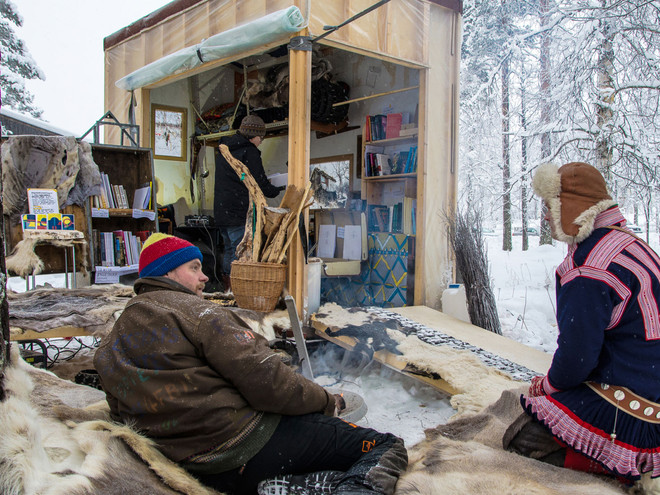
Joar Nango STUDIO VISIT
Joar Nango (Sámi, born in 1979, Áltá, Norway; lives and works in Áltá, Norway) works with site-specific installations and self-made publications that explore the boundary between architecture, design and visual art.
His work relates to questions of Indigenous identity, often through investigating contemporary architecture. Joar has explored modern Sámi spaces through the self-published zine Sámi Huksendáidda: the Fanzine, the design project Sámi Shelters and the mixtape/clothing project Land & Language.
He is a founding member of the architecture collective FFB and is currently setting up a network of Sámi architects across Sápmi through the ongoing Indigenous architecture library project.

Kristin Tårnes STUDIO VISIT
“After I finished my MA degree at the Trondheim Academy of Fine Arts, I moved to Tromsø, in the opposite direction of most of my classmates. Ever since I moved here in 2011 I have worked directly the place where I live in different ways. I have done projects which emerged from specific places like a small forgotten garden, the last remaining industry in the city center of Tromsø, a potentially cursed museum and a former museum almost falling apart.
The last years I have worked mainly with film, and the two latest works is filmed in a way so that it gives the audience a feeling of moving through the place while you get a glimpse of some of the stories related to it.
I have also been very interested in contributing to the development of the art scene in Tromsø, and have among other things previously been involved in the artist run space Kurant for several years, and initiated the studio collective TKF-Loftet above Tromsø kunstforening."
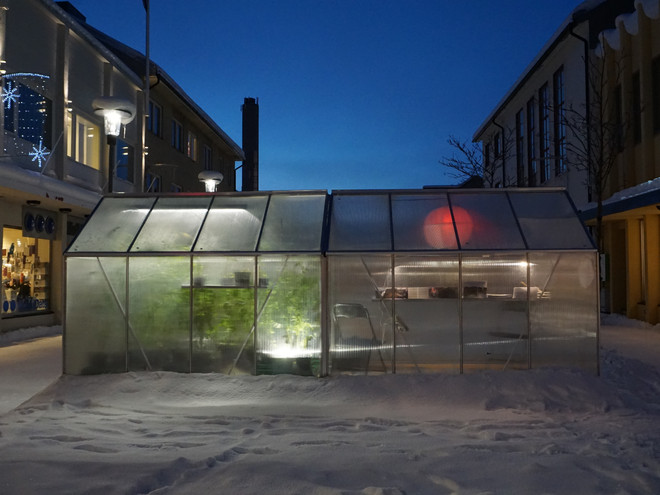
Irene Rasmussen STUDIO VISIT
“I work with site-specific projects, installations and sculptures. The projects are connected to site and place, often in temporarily stages with degradable materials.
The project “From Seed to Sim” describes specific plant species abilities to accumulate heavy metals in contaminated ground, and how these metals can be extracted, and clean the soil after a growing season. The project was initially planned for the Nikel industrial plant in Russia, however, due to covid19 it had to be developed into a similar project in connection to the mining industry in Kirkenes.
“The Sepwork Garden” was organized as a Phytoremediating garden at the marine landfill at As Sydvaranger in Kirkenes 2021. The name, “Sepwork Garden” referred to Sydvaranger`s seperationplant located close by the garden. The plants were harvested and dried as an installation at the gallery Terminal B, Pikene på Broen`s project and gallery space. Metals from the plants ash are now extracted into sculpture material and will become further elaborated and presented as a result of the plants accumulation during a growing season."